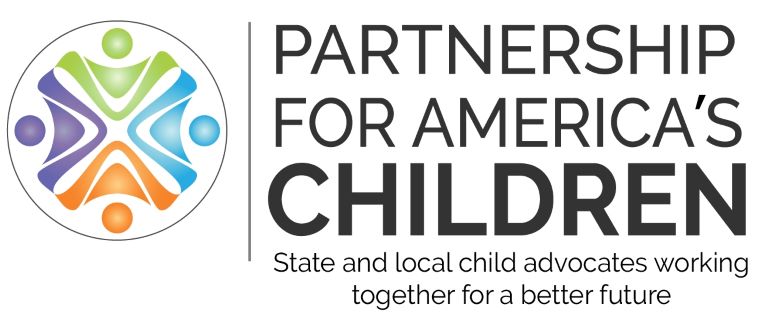CAFC’s Review of the Governor’s Proposed Fiscal Year 2026 Illinois State Budget
Illinois Governor J.B. Pritzker has proposed a state budget for the next fiscal year that holds the line on income and corporate taxes, increases investments in K-12 public schools and higher education, makes a full pension contribution, cuts a state health insurance program that served undocumented immigrants ages 42-64, and provides a cautionary tale of what could be ahead in 2026.
The budget outlines revenues and expenditures for Fiscal Year 2026 (FY26) that begins on July 1st of this year. While not rosy, the projected $55.5 billion in general funds[1] and the $55.2 billion in expenditures is much better than the $3.2 billion deficit the Governor’s Office of Management and Budget projected in November.
Revenue
The November estimate for FY26 individual income tax revenue was $27.8 billion. It is now pegged at $28.7 billion. Corporate income tax revenue is slightly below the November projection, and sales tax revenue is listed as an increase of $326 million from the November projection.
The Governor’s proposal also calls for raising another $468 million by:
- Offering a delinquent tax payment program where taxpayers with an outstanding tax payment from prior years can make the payment without penalty or interest
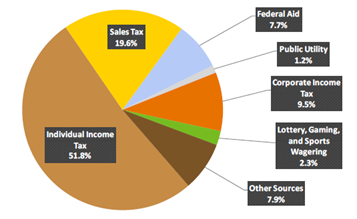
General Funds Revenue $55.5 billion
Image source: Office of Management and Budget($198 million in anticipated revenue).
- Changing the tax rate applied to revenue from casino table games, which is now more beneficial to larger casinos ($100 million in anticipated revenue)
- Pausing a shift of state sales tax revenue from motor fuel purchases to the Road Fund ($171 million in anticipated revenue)
Yet, overlaying the revenue projects is the overall uncertainty of what the federal government will do in the next several months.
- On February 1st, President Donald Trump imposed tariffs of 25% on goods from Mexico and Canada and a 10% on goods from China. He then suspended for 30 days the tariffs on Mexico and Canada.
- On February 10th, the President announced a 25% tariff on steel and aluminum. These tariffs are scheduled to become effective March 12th.
- The President has also stated his intentions to impose or increase U.S. tariffs to match the tax rates that other countries charge on U.S. imports[2].
The state’s budget office used a S&P Global economic forecast in its revenue projections, which took into account some tariff activity but not all of what is noted above. Depending on whether U.S. consumers switch to similar domestic products, if such items are produced domestically, it could impact consumer spending as well as business production. The following statement is in the proposed budget:
The Trump Administration’s proposed tariffs on exports from Illinois’ top trading partners like Canada and Mexico will have devastating impacts on Illinois’ small, medium, and large companies, disrupting supply chains and this progress, increasing their costs, creating chaos and wreaking havoc on their ability to operate. Anticipated retaliatory tariffs on Illinois exports will have a quieting effect on Illinois companies’ global reach, harming businesses and raising prices for consumers[3].
Expenditures
The proposed expenditures of $55.2 billion represents an increase of approximately 2.5% over estimated FY25 expenditures[4]. The bulk of the increase is due to:
- A $350 million increase for the evidence-based school funding formula for K-12 education
- A $436 million increase in required pension payments under the state’s pension formula to reach 90%.
- Medical expense increases for the Department of Healthcare and Family Services ($397 million) and the Department of Central Management Services – group health insurance ($341 million).
Excluding pension payments, debt services, and statutory transfers (which total just over 23% of all proposed expenditures), the largest segment of the remaining funds (or what is termed the Operating Budget) is for education followed by human services.
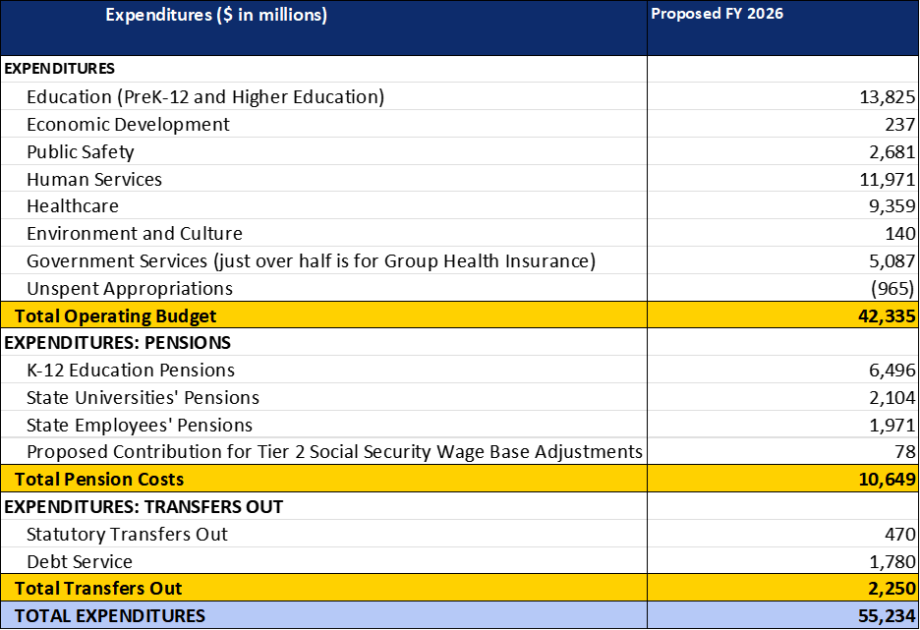
Source: Office of Management and Budget
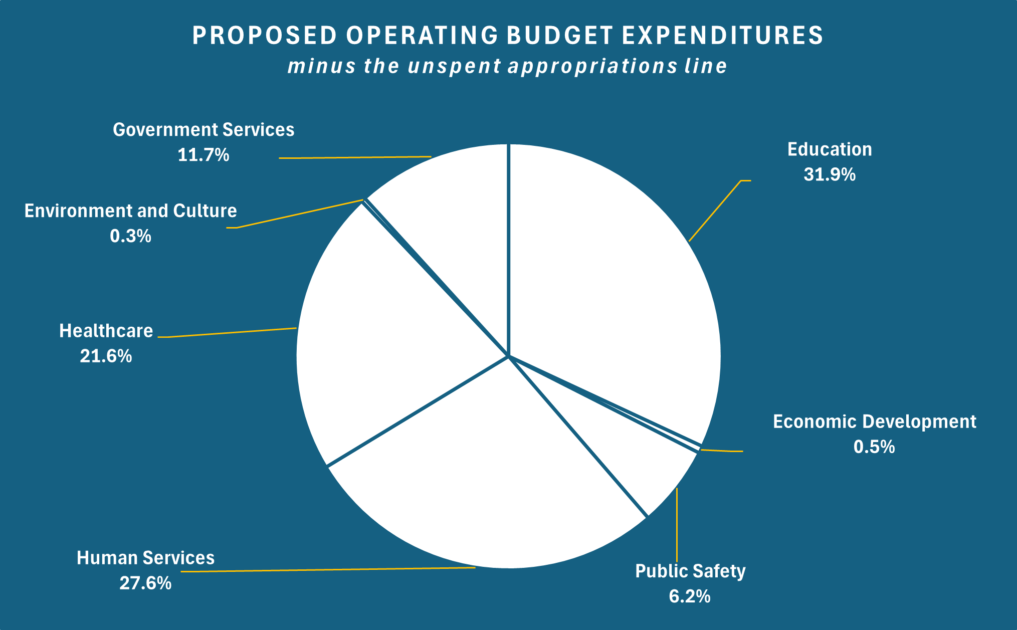
Immigrant health care and services
Yet, while there is also a significant increase for the Department of Healthcare and Family Services in medical costs, the Governor proposes discontinuing the Health Benefits for Immigrant Adults (HBIA) Program which provided insurance coverage for undocumented residents ages 42-64. A program for undocumented seniors remains in place.
Because enrollment and costs for the HBIA program were higher than expected after the state established the program, it has capped enrollment since the middle of 2023. The Governor’s Office estimates a savings of $330 million in general funds spending with the proposed FY26 HBIA elimination[5].
In addition, the budget reflects a reduction of $129 million in state funds from FY25 Enacted Appropriations, $82 million from FY25 Estimated Expenditures, for Welcoming Centers. Funding for the Immigrant Integration Services line item within the Department of Human Services is level.
PreK-12 Education
The proposed FY26 budget includes an additional $350 million for the state’s evidence-based funding formula for public schools. Illinois overhauled the formula in 2017, which addresses how the state distributes funds to local school districts, in an effort to further reduce disparities in district able dollars across the state. With passage of the revision, legislators pledge to add $350 million dollars above the prior year for each of the next 10 years.
The budget contains level funding for the Early Childhood Block Grant Program. Last year, the state added $75 million to the ECBG Program to increase the number of slots for early childhood programs. It did so as well from FY23 to FY24.
The Illinois State Board of Education (ISBE) budget also increases funding for school categorical grants by nearly $20 million. These grants are required by state statutes for specific purposes such as special education, transportation, and the school breakfast and lunch program. According to the Governor’s Office, the proposed budget fully funds the Special Education-Orphanage Tuition and Regular Orphanage Tuition budget lines.
The FY25 budget approved last May included an additional $50 million for after-school programming. This was, in part, to address a situation that occurred in 2023 with a miscalculation of available federal funds[6]. In a June ISBE memo, staff stated it would be working with General Assembly leadership and the Governor’s Office on guidelines for distributing the funds. As of this writing, ISBE has not issued a Request for Proposals or other directions for release of the funds. The FY26 budget does not contain a similar line item. However, there is level funding of $25 million in another line item for after school programming.
This budget does not address the projected Chicago Public Schools deficit for the 2025-2026 academic year of at least $508.7 million[7].
Higher Education
The Governor’s proposed budget increases funding for public universities and community colleges by a total of $46 million (or a 3% increase in general funds over FY25).
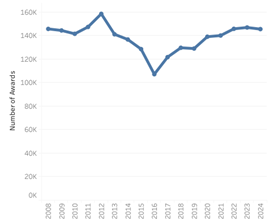
Number of MAP Awards by Fiscal Year
Source: Illinois Student Assistance Commission
The Governor proposes increasing funding for the Monetary Award Program (MAP) by $10 million bringing the total proposed expenditure to $721.6 million. The AIM High Grant Program has level funding[8]. According to the budget, approximately 162,700 students benefit from MAP and AIM High.
The budget contains level funding for the Early Childhood Access Consortium for Equity Scholarship Program. The state created the program in 2021 to address a shortage of qualified early childhood educators. Individuals who have worked in early childhood education and who are seeking additional credentials or a degree in early childhood education may be eligible.
Finally, there is $21.7 million in the budget for the new Department of Early Childhood as it continues to build its operational infrastructure. In FY27, the Department is scheduled to house the Early Childhood Block Grant Program (now at the State Board of Education); the Child Care Assistance Program, Home Visiting programs, and Early Intervention services (now at the Department of Human Services); and day care licensing (now at the Department Children and Family Services). One of the goals of the new agency is to make it easier for families to access services.
Department of Human Services
The Governor’s proposed budget contains a request for an FY25 supplemental appropriation of $75 million for the Child Care Assistance Program and then another increase for FY26 of $85 million. In 2024, the CCAP program served 140,000 children monthly. The Governor’s Office estimates the number will be near 150,000 by the end of FY26[9].
The SMART Start line-item shows a $90 million increase. The state began the program in 2023 with the intention of providing every child access to preschool, reaching more vulnerable families with support early in a child’s life, and increasing funding for childcare providers (with the dual goals of raising wages and improving classroom qualify)[10].
According to budget documents, the increased funds are to annualize the cost of Early Childhood Workforce Compensation Contracts and replace expiring federal childcare funding. The Workforce Compensation Contracts allow providers to receive funding in advance of services to help cover the costs of higher wages and operating a classroom.

There is a $15 million increase for Early Intervention services, which helps infants and toddlers facing developmental challenges. About two-thirds of this amount is to support rate enhancements for providers.
The budget contains level funding for home visiting programs and a 3% Cost of Living Adjustment for TANF (Temporary Assistance to Needy Families) cash assistance. As note later in the blog, TANF funding could be impacted by future federal action.
Department of Children and Family Services
The budget for the Illinois Department of Children and Family Services (DCFS) includes $53.7 million funding for an additional 100 staff members to continue managing caseloads. For decades, DCFS has been under a consent decree to ensure the Department provided adequate services to youth, that children are placed in the most family-like setting possible, and that (under the last amendment to the decree) the agency maintain enough staff to so there is a maximum of 10 cases per child abuse and neglect investigator.
The budget also contains an additional and a $24 million to support salary increases for private partners and an increase of $15.8 million to, in part, support relative caregivers. Earlier this year, the Governor signed the Kinship in Demand Act (now P.A. 103-1061), which allows DCFS to develop more flexible standards to certify grandparents and other relatives who are able to safely care for youth in DCFS’s care. The law also creates a path for more youth in care to find permanent homes through guardianship[11].
Other proposed expenditures
- Proposed funding under the Department of Public Health (DPH) for the agency’s birth equity initiative is level.
- The FY26 DHP budget also contains level funding for maternal and child health services
- Within the Governor’s proposed FY26 Capital Budget is $300 million (that would fall under a new bond authorization request) to remediate and prepare surplus state property for economic development. The Capitol Budget also contains another $200 million for expanded site readiness programs.
Not included in the proposed FY26 state budget is a plan for addressing a potential transit shortfall at the Regional Transportation Authority (RTA). According to the agency, it is facing a deficit of $770 million next year. The legislature has been discussing changes to the RTA’s governance and operations structure.
Federal Activity
However, the budget approved by the General Assembly could look very different from the proposed budget depending on future activity by the federal government. As of this writing, Congress is debating a tax and budget package that could significantly impact Medicaid, TANF, the Supplemental Nutrition Assistance Program, and a wide range of other social services. It is also facing the expiration of a continuing resolution funding the federal government until March 14th.
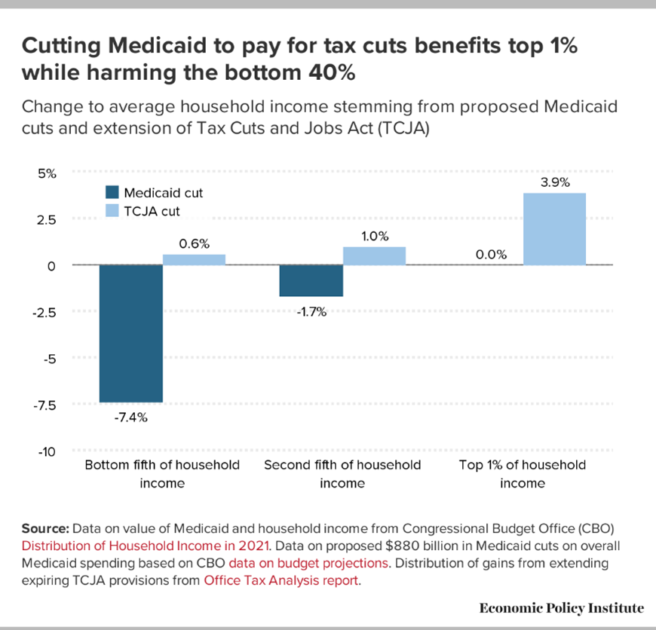 A budget resolution approved by a U.S. House committee, and awaiting a full House vote, would provide for $4.5 trillion in tax breaks and deductions (over 10 years) and $2 billion in budget cuts – with a potential $880 billion cut to Medicaid.
A budget resolution approved by a U.S. House committee, and awaiting a full House vote, would provide for $4.5 trillion in tax breaks and deductions (over 10 years) and $2 billion in budget cuts – with a potential $880 billion cut to Medicaid.
While uncertain if Congress would implement this by block grant funding to states (appropriations to states capped at a dollar level versus a reimbursement percentage) or cuts to specific elements of the Medicaid program remains to be seen.
Currently, the state reimburses the state for about half the cost of the majority of Medicaid expenses. However, the Affordable Care Act opened the Medicaid program up to non-disabled adults at higher income levels and as an incentive provided for a 90% federal match rates to states that expanded the Medicaid pool. Close to 770,000 Illinois receive coverage under the expanded Medicaid program[12]. Illinois law stipulates that it would end the Medicaid expansion program if federal funding is cut.
Project 2025, a document put together by the Heritage Foundation, proposes eliminating funding for Head Start – a preschool program serving low-income children. In Illinois, Head Start funding allows providers to serve more than 28,000 children (and those providers employ more than 9,400 individuals)[13].
Other programs from child care to energy bill assistance to TANF (just to name a few) could be impacted by federal budget cuts.
The Illinois legislature’s scheduled adjournment date is May 31st. Children’s Advocates for Change will be tracking developments in Springfield as well as Washington D.C. and advocating for a state budget that meets the needs of all Illinois children.
Written by Mitch Lifson
Footnotes
[1] Under state law the general funds are comprised of the General Revenue Fund, the Education Assistance Fund, the Common School Fund, the General Revenue-Common School Special Account Fund, the Fund for the Advancement of Education, the Commitment to Human Services Fund, and the Budget Stabilization Fund.
[2] Boak, Josh, “Trump signs a plan for reciprocal tariffs on US trading partners, ushering in economic uncertainty”, Associated Press, February 13, 2025.
[3] Proposed Fiscal Year 2026 Illinois State Budget, p. 28
[4] This includes proposed FY25 general funds supplemental appropriations of $550 million.
[5] Capitol News Illinois, “Blac, Latino lawmakers criticize Pritzker’s proposed budget”, February 19, 2025
[6] Hancock, Peter, “Groups Demand Release of After-School Program Funding”, Capitol News Illinois, February 3, 2025.
[7] Civic Federation, Financial Landscape Analysis of the Chicago Public School District FY2025, January 13, 2025.
[8] Formally titled the Aspirational Institutional Match Helping Illinois Grow Higher Program (AIM HIGH), the program is designed to encourage Illinois residents to attend Illinois public universities. The grant is renewable for a student assuming he or she continues to meet the eligibility requirements.
[9] Illinois Office of Management and Budget, “Illinois Budget in Brief”, p. 18, Proposed Fiscal Year 2026 Illinois State Budget, p. 341
[10] https://www.ilgateways.com/smart-start/smart-start-workforce-grants
[11] Press Release, Office of the Governor, February 5, 2025
[12] HFS briefing on February 19, 2025;
[13] National Head Start Association, Illinois 2025 Head Start Profile



